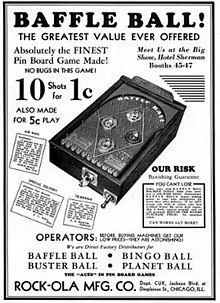Baffle Ball
 | |
| Manufacturer | D. Gottlieb & Co. |
|---|---|
| Release date | 1931 |
| Design | David Gottlieb |
| Production run | > 50,000 |
Baffle Ball is a pinball machine created in 1931 by David Gottlieb, founder of the Gottlieb amusement company.
Gameplay
For one US cent players got ten balls. They would be fired up onto the playfield and fall into pockets and holes. Some ball targets were worth more than others, and players tried to fire the ball at just the right speed. Unlike later pinball machines, Baffle Ball had no flippers. The best target was the Baffle Ball, a tiny hole at the top which would double all points. The game used no electricity, and all scoring had to be done by hand.
Description
While bagatelle-derived "marble games" have long existed previously, Baffle Ball was the first commercially successful game of its type, being affordable enough for store and tavern owners to quickly recoup the machine's cost. Over 50,000 machines were made, jump-starting the arcade pinball field; it spawned a home version in 1932 called Baffle Ball Senior.[1]
Baffle Ball was responsible for the launch of the company Gottlieb that went on to make pinball machines such as Ace High and Black Hole. The game sat on top of bar counters and the bartender might award prizes for high scores.[citation needed] It is very popular with and sought after by collectors.[citation needed]
Digital Version
The table was virtually recreated in pinball simulation video game, Microsoft Pinball Arcade. Although adjustments were made to the game rules. Instead of the normal silver balls, colored balls, that matches the color of the target, are played. If the player lands the ball in the target that matches exactly the color of the ball extra points are awarded.
See also
- Play-Boy - the follow up game
References
External links
- Baffle Ball at the Internet Pinball Database
